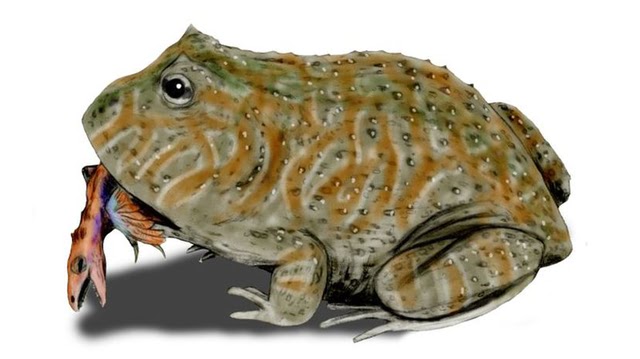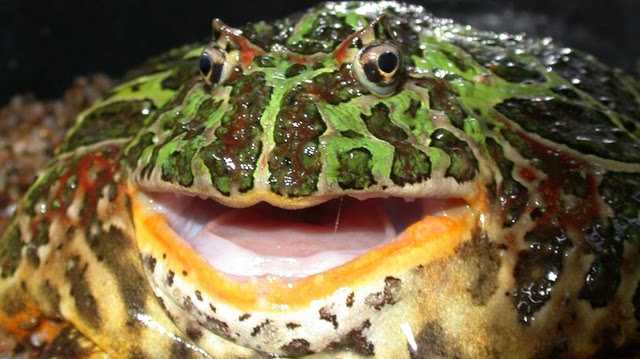Quck answer
A prehistoric frog named Beelzebufo, which lived about 68 million years ago, had a bite force strong enough to eat small dinosaurs and snakes. Its skull was nearly 10 inches long and had wide jaws with sharp teeth, making it one of the largest frogs ever discovered. Scientists believe Beelzebufo lived in Madagascar and may have fed on anything it could catch, including other frogs, mammals, and reptiles. Its discovery sheds light on the diversity of ancient amphibians and their ability to adapt to different environments.
Extinct Animals

The discovery of a new species of amphibian in Madagascar in 1993 shocked scientists due to its giant size. Named Beelzebufo ampinga, the creature could measure up to 16 inches long and weigh over 9 pounds. Experts believe that its diet consisted of small crocodylians, birds, lizards, snakes, small mammals, and possibly baby dinosaurs. Recent research shows that the Beelzebufo had a strong bite, which would have been crucial to overpower its prey.
Powerful Bite of the Pacman Frog
Scientists have recently studied the jaw mechanics of the horned frogs, which are the closest living relatives of the Beelzebufo. These frogs, also known as Pacman frogs, have comically large mouths and strong jaws, making them punishing biters. Researchers have found that the bite force of the Pacman frog is very high, a topic that has not been studied in frogs before. The study has broken new ground in the field of amphibian jaw strength.

The South American horned frog, also known as the Pacman frog, has a tremendous bite force.
Kristopher Lappin
A Glimpse into the Past
Researchers led by David Lappin conducted a study on Ceratophrys cranwelli, also known as Cranwell’s horned frogs, to gain insight into the jaw strength of their extinct relative, Beelzebufo. They found that an individual frog’s bite force correlated with its body measurements. For example, a small frog with a head measuring only 1.8 inches across can deliver 30 Newtons of force. By comparison, the largest Ceratophrys frogs can administer around 500 Newtons when biting down, while Beelzebufo could deliver a whopping 2,200 Newton bite. This is equivalent to the bite force of a female tiger and stronger than that of a gray wolf.
The study also revealed that Beelzebufo shared certain habits with its living relatives, such as using their mouths for both defense and hunting. Horned frogs have extremely sticky tongues and vice-like jaws that make it difficult for prey to escape. Pacman frogs, on the other hand, hide in mud or leaf litter and wait for prey to come to them.
While anatomical evidence suggests that Beelzebufo had a strong bite, there are some differences between the extinct species and its living relatives. For example, Beelzebufo did not have the pointed horns above the eyes that are present in Ceratophrys frogs. However, both species have wide skulls with ample room for strong jaw muscles.
Pacman frogs are known for their voracious appetites and are not picky eaters. They will eat just about anything, including rodents, birds, fish, and even other frogs. In some cases, they have been known to use their own feet as lures to attract prey.
FAQ
1. What is the prehistoric frog known as?
The prehistoric frog is known as Beelzebufo, which means “devil frog” in Greek. It lived about 68 million years ago, during the Late Cretaceous period.
2. How big was the Beelzebufo?
The Beelzebufo was about the size of a beach ball, with a length of up to 41 centimeters and a weight of up to 4.5 kilograms. This made it one of the largest frogs to ever exist.
3. What did the Beelzebufo eat?
The Beelzebufo had a monstrous bite and was capable of eating small dinosaurs and other small vertebrates. It had a powerful jaw and sharp teeth that allowed it to crush prey with ease.
4. Where was the Beelzebufo found?
The Beelzebufo was found in Madagascar, where it lived in the wetlands and swamps that covered the island during the Late Cretaceous period. It is believed that it went extinct along with the dinosaurs about 66 million years ago.
5. How was the Beelzebufo discovered?
The Beelzebufo was discovered in 2008 by researchers from Stony Brook University in New York. They found fossils of the frog’s skull, jawbone, and other bones in Madagascar.
6. What makes the Beelzebufo unique?
The Beelzebufo is unique because of its size and its powerful bite. It is also one of the few known frogs to have lived during the Late Cretaceous period.
7. Could the Beelzebufo jump like modern frogs?
It is not known if the Beelzebufo could jump like modern frogs, as there is no evidence to suggest that it had strong leg muscles. However, it is believed that it could swim in water and move on land using its powerful hind legs.
8. How does the Beelzebufo compare to modern frogs?
The Beelzebufo is much larger than modern frogs and had a different diet and lifestyle. Modern frogs typically feed on insects and other small invertebrates, while the Beelzebufo was a predator that fed on small vertebrates. Additionally, modern frogs have adapted to survive in a wide range of habitats, while the Beelzebufo was adapted to the wetlands and swamps of Madagascar during the Late Cretaceous period.





Leave a Reply